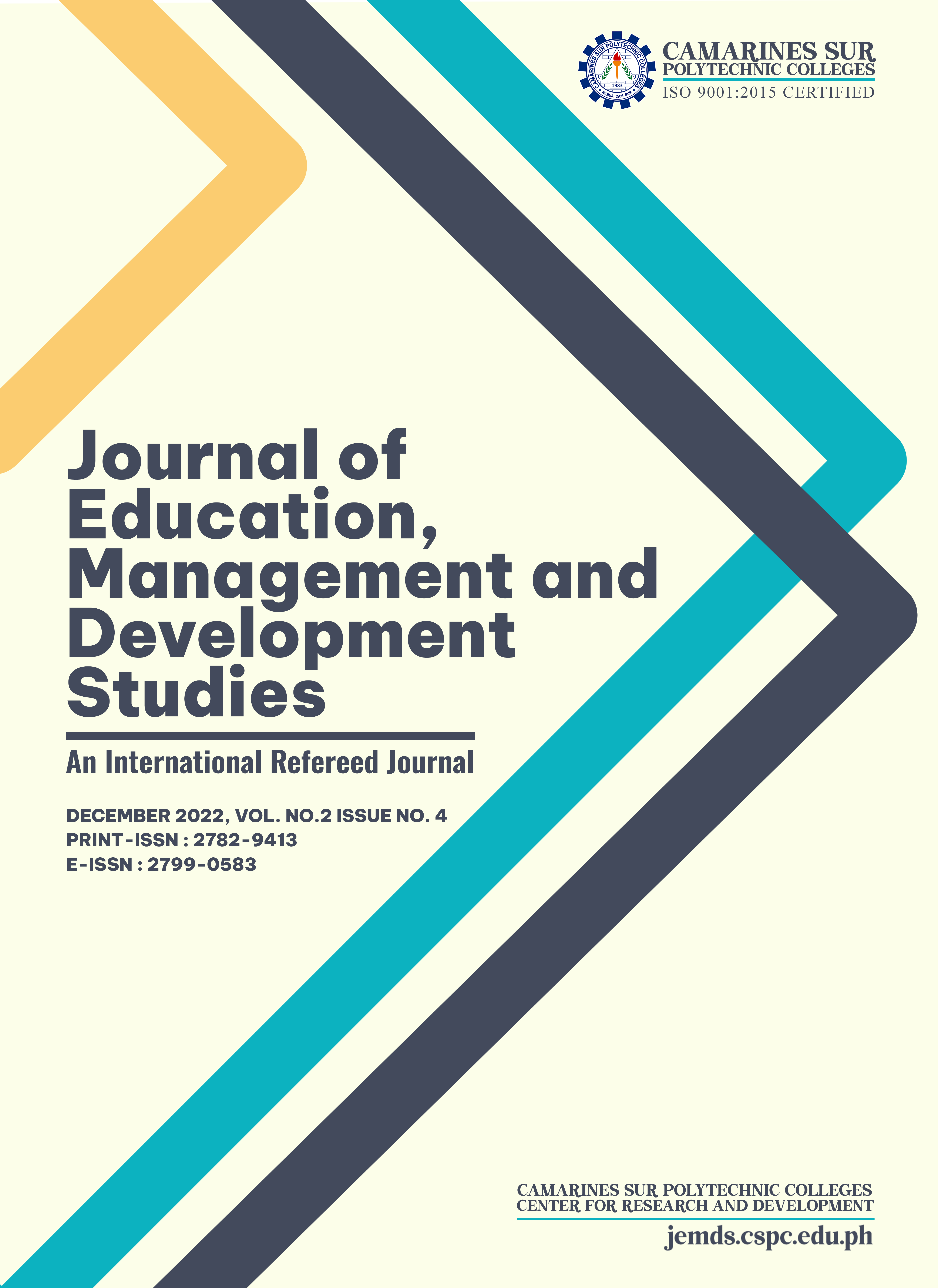Abstract
The Seaweeds Culture is one of the livelihood initiatives extended by the FishCORAL Project funded by the United Nations-International Fund for Agricultural Development (UN-IFAD) with the Bureau of Fisheries and Aquatic Resources (BFAR) to the fishing households in Barangay Rizal and Libertad, Esperanza, Masbate, Philippines. The study aimed to analyze the socioeconomic characteristics of household beneficiaries, identify the different types of livelihood assets, and evaluate the livelihood key performance of Esperanza Seaweeds Culture-Enterprise Federation. The study included the twenty-one beneficiaries, and data were treated based on cross-sectional quantitative data were gathered through focus group discussion and key informant interviews. It was found out that the household beneficiaries are mostly potential members of the labor force. The household income is insufficient, which translates to high poverty incidence. The income and expenditure approach as PSA's measure of poverty confirmed this. The primary livelihood assets are consumer durables, enterprise federation, credits as significant financial capital, and government transfers associated with buffering mechanisms to sustain the family needs. There is relevance and initial impact, which results in improved livelihood and some improvement in women empowerment. The claimed improvement in income could not be associated with project impact as the culture has just started. There are key challenges to the efficiency and sustainability of the project, especially from the end view of natural and anthropogenic disturbances. These significant risks are appropriately counteracted when the association does have a sustainability plan. The adaptive capacity of the association must be enhanced. Along these ends, the technical backstopping of BFAR, academe, and other agencies are very vital.
References
Alkire, S., Meinzen-Dick, R., Peterman, A., Quisumbing, A., Seymour, G., Vaz, A., (2013).
The women’s empowerment in agriculture index. World Development, 52, 71-91.
https://doi.org/10.1016/j.worlddev.2013.06.007.
Bak, U., Gregersen, Ó. & Infante, J. (2020). Technical challenges for offshore cultivation of
kelp species: lessons learned and future directions. Botanica Marina, 63(4), 341-353.
https://doi.org/10.1515/bot-2019-0005
Bridgman, B. (2016). Home productivity. Journal of Economic Dynamics and Control, 71,
-76. https://doi.org/10.1016/j.jedc.2016.08.003
Chen, J. & James, M., (2021, March 20). Financial asset. Investopedia.
https://www.investopedia.com/terms/f/financialasset.asp
Department for International Development, (n.d.). Sustainable guidance sheets.
Dioneda R.R., Asejo, R.B., Burce, R.B., Balangawan, R.R., & Tumbaga, B.S. 2019. Status of Corals and Coral Reef Fishes in Acid Gulf, pp. 33-51. In Dioneda, R.R., Naz, GAA & Torres, E.E. (Eds), Participatory Resource and Socio-Economic Assessment of Asid Gulf. Terminal report submitted for the Fisheries, Coastal Resources and Livelihood Project, Department of Agriculture Bureau of Fisheries and Aquatic Resources, Quezon City. Bicol University Center for Policy Studies and Development, Legazpi City. 144 pp.
FishCORAL Project, (n.d.). About us. Retrieved July 14, 2021, from
http://fishcoral.bfar.da.gov.ph/about-us
Guiriba, M.A.B., R.B. Asejo, M.T.B. Bron and G. Espinosa, H.L. Marana and D.N. Sy. 2019. Status of seagrass and seaweeds communities in Acid Gulf, Philippines. Pp 52-69. In Dioneda, R.R., Naz, GAA & Torres, E.E. (Eds), Participatory Resource and Socio-Economic Assessment of Acid Gulf. Terminal report submitted for the Fisheries, Coastal Resources and Livelihood Project, Department of Agriculture Bureau of Fisheries and Aquatic Resources, Quezon City. Bicol University Center for Policy Studies and Development, Legazpi City. 144 pp.
Hayes, A. (2019, July 8). Physical asset. Investopedia.
https://www.investopedia.com/terms/p/physicalasset.asp
Kasim, M., et al., (2019). Floating Cage: A new innovation of seaweeds culture. Emerging
Technologies, Environment and Research for Sustainable Aquaculture.
DOI: 10.5772/intechopen.90035
Kenton, W. & Sonnenshen, M., (2020, September 4). Human capital. Investopedia.
https://www.investopedia.com/terms/h/humancapital.asp
Kim, J., Stekoll, M., & Yarish, C., (2019). Opportunities, challenges and future directions of
open-water seaweed aquaculture in the United States, Phycologia, 58(5), 446-461.
DOI: 10.1080/00318884.2019.1625611
Mailath, G. & Postlewaite, A., (2006). Social assets. International Economic Review, 47(4),
-1091. https://www.jstor.org/stable/3877453
Mateo, J.P., Campbell, I., Cottier-Cook, E.J. et al., (2020). Analysis of biosecurity-related
policies governing the seaweed industry of the Philippines. Journal of Applied
Phycology, 32, 2009–2022. https://doi.org/10.1007/s10811-020-02083-7
Organisation for Economic Co-operation and Development [OECD], (n.d.). Natural assets.
Glossary of Statistical Terms. ttps://stats.oecd.org/glossary/detail.asp?ID=1729
Philippine Statistics Authority, (2020, June 04). Updated 2015 and 2018 full year official
poverty statistics. https://psa.gov.ph/poverty-press-releases/nid/162559
Rebours, C., Marinho-Soriano, E., Zertuche-González, J.A. et al., (2014). Seaweeds: An
opportunity for wealth and sustainable livelihood for coastal communities. Journal
of Applied Phycology 26, 1939–1951. https://doi.org/10.1007/s10811-014-0304-8
Sievanen, L., Crawford, B., Pollnac, R., & Lowe, C., (2005). Weeding through assumptions
of livelihood approaches in ICM: Seaweed farming in the Philippines and
Indonesia. Ocean and Coastal Management, 48(3-6), 197-313.
https://doi.org/10.1016/j.ocecoaman.2005.04.015
Trono, G. & Largo, D. (2019). The seaweed resources of the Philippines. Botanica Marina,
(5), 483-498. https://doi.org/10.1515/bot-2018-0069

This work is licensed under a Creative Commons Attribution-NonCommercial-NoDerivatives 4.0 International License.
Copyright (c) 2023 Journal of Education, Management and Development Studies





